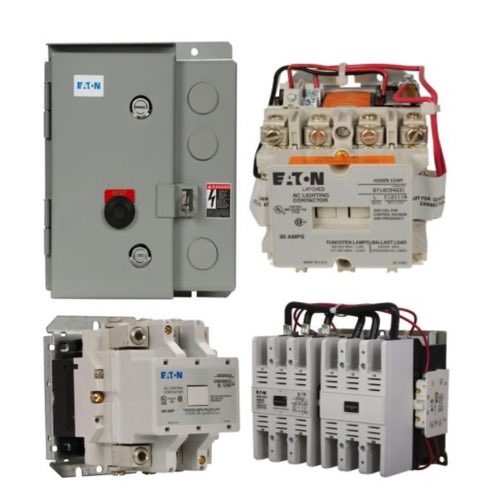Eaton Starter Contactors

Eaton starter contactors are fundamental devices in motor control systems. They can be used in almost any motor control application with a wide range of voltage and power levels. IEC contactors and NEMA contactors are available. The reversing models are excellent for applications requiring a motor to not only start and stop but to reverse direction as well. Eaton reversing contactors can perform that task reliably. The contactors themselves can handle a wide variety of applications. The use of reversing contactors seems to be more product-specific than the non-reversing types. Regardless, both types of contactors are compact and suited for modern panel designs.
Overload relay integration with Eaton starter contactors improves motor protection and decreases the likelihood of damage from overcurrent and overload conditions. These contactors also come with coil voltage options that are so versatile they satisfy nearly all power requirement scenarios. When the contactors and starter from Eaton are used together, they serve a solution that is effective, reliable, and long-lasting in the industrial setting. Add in some of Eaton's accessories—like auxiliary contacts and control devices—and the configuration can easily be customized to fulfill motor control requirements that are anything but standard.
More Information about Eaton Starter Contactors
Eaton’s contactors and starters are designed for easy installation and maintenance, which is a big reason why they ensure a very minimal amount of downtime. When you look at the Eaton line of products, they appear to support an awful lot of applications. Between pumps and compressors and conveyors, they seem to have something for everyone. But that's not all. You can get Eaton starters and contactors in a closed configuration or an open configuration, providing something of a weatherproof benefit for the different environments in which these products might have to work.
FAQs
Are Eaton starter contactors a space saving, effective solution for efficient motor control?
Yes, Eaton starter contactors are a space-saving, effective solution for efficient motor control, offering compact designs, reliable performance, and enhanced motor protection for various industrial applications.
Motor Control Basics
Motor control allows operational control of electrical motors in various environments.
Motor control circuits provide a safe way to operate electrical motors. Back when motor control circuits were in their infancy, it would have been common to see a simple disconnect switch that would be used to turn on and off a motor. Depending on the size of the motor and how much voltage was required, operating this disconnect would have been dangerous, with a very high possibility of arcing or electrocution. Not to mention that when the disconnect was actuated, the large amount of inrush current would have damaged the motor over time.
In today's motor control circuits, there are a few common pieces of hardware.
A circuit breaker is used to protect the motor and any hardware downstream. A contactor and an overload relay are connected together and function in tandem to allow for remote and safe operation of the motor. The contactor functions much like a relay, allowing for a smaller electrical circuit to remotely close the motor contacts, starting the motor. The overload relay is designed to protect the motor in the case of a prolonged overcurrent event. These two devices are wired in series, so that if the overload relay detects an overcurrent event, the contactor will open the motor contacts, shutting off power to the motor.
The other two most common types of motor control hardware are a soft starter and a Variable Frequency Drive (VFD).
Both of these devices function in a similar way to the motor circuit with some added functions. The soft starter is designed to reduce large inrush current to the motor upon startup. This “soft starting” of the motor will prolong its life and allow for safer operation. The VFD performs the soft start functions, but also allows for speed control of the motor. This speed control is critical in many different environments and has made VFDs one of the most common and safe to use motor control circuits today.

